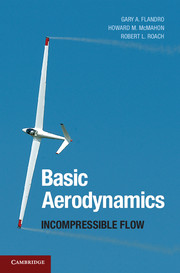Book contents
- Frontmatter
- Contents
- Preface
- 1 Basic Aerodynamics
- 2 Physics of Fluids
- 3 Equations of Aerodynamics
- 4 Fundamentals of Steady, Incompressible, Inviscid Flows
- 5 Two-Dimensional Airfoils
- 6 Incompressible Flow about Wings of Finite Span
- 7 Axisymmetric, Incompressible Flow around a Body of Revolution
- 8 Viscous Incompressible Flow
- 9 Incompressible Aerodynamics: Summary
- Index
- References
3 - Equations of Aerodynamics
Published online by Cambridge University Press: 05 February 2012
- Frontmatter
- Contents
- Preface
- 1 Basic Aerodynamics
- 2 Physics of Fluids
- 3 Equations of Aerodynamics
- 4 Fundamentals of Steady, Incompressible, Inviscid Flows
- 5 Two-Dimensional Airfoils
- 6 Incompressible Flow about Wings of Finite Span
- 7 Axisymmetric, Incompressible Flow around a Body of Revolution
- 8 Viscous Incompressible Flow
- 9 Incompressible Aerodynamics: Summary
- Index
- References
Summary
Introduction
To solve the fundamental problems of aerodynamics defined in Chapter 1, it is necessary to formulate a mathematical representation of the underlying fluid dynamics. The appropriate mathematical expressions or sets of equations may be algebraic, integral, or differential in character but will always represent basic physical laws or principles. In this chapter, the fundamental equations necessary for the solution of aerodynamics problems are derived directly from the basic laws of nature. The resulting mathematical formulations represent a large class of fluid mechanics problems within which aerodynamics is an important subclass.
Some problems in aerodynamics require solutions for all of the variables needed to describe a moving stream of gas—namely, velocity, pressure, temperature, and density. Because velocity is a vector quantity (i.e., with magnitude and direction), in a general case there are three scalar velocity components. Thus, in many cases of interest, there is a total of six unknowns: three velocity components and the scalar thermodynamic quantities of pressure, temperature, and density.* This requires six independent equations to be written to solve for the six unknowns. The physical laws of conservation of mass, momentum, and energy supply five such equations (i.e., the momentum equation is a vector equation; therefore, conservation of momentum leads in general to three component equations). For all of the subject matter in this book, the assumption of an ideal gas is physically realistic. Thus, the perfect gas law (i.e., equation of state) p = ρRT, which relates pressure, density, and temperature, supplies the final equation needed to solve for the six unknowns.
- Type
- Chapter
- Information
- Basic AerodynamicsIncompressible Flow, pp. 48 - 109Publisher: Cambridge University PressPrint publication year: 2011

